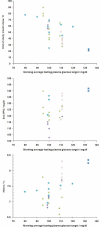Treat-to-target insulin titration algorithms when initiating long or intermediate acting insulin in type 2 diabetes
- PMID: 19885117
- PMCID: PMC2769634
- DOI: 10.1177/193229680700100412
Treat-to-target insulin titration algorithms when initiating long or intermediate acting insulin in type 2 diabetes
Abstract
Background: Until recently, titration of insulin in type 2 diabetes clinical trials was typically left up to the investigator's discretion with a simple statement of the target ranges for glucose. In type 2 diabetes trials the average glycemic control achieved was usually less than desirable. Since then a number of trials have been conducted and reported utilizing various algorithms under various conditions. The objective of this article is to provide a review of the evidence to date.
Methods: In addition to studies already identified through work in the area, the literature was searched using PubMed with the search words "insulin and titration" and subsequently "insulin and algorithm" from which studies starting insulin therapy using insulin titration algorithms in type 2 diabetes were selected.
Results: The different algorithms and achieved results for glycemic control and hypoglycemia, as well as factors appearing to impact the results, are reviewed.
Conclusion: The recent introduction of rigorously implemented insulin titration algorithms when adding on basal insulin to oral drugs in inadequately treated type 2 diabetes patients has led to better average glycemic control with little risk of severe hypoglycemia, as long as the morning fasting plasma glucose target is not lower than 100 mg/dl. Insulin titration algorithms have undergone and continue evolution in the direction of increased patient control.
Keywords: FPG; NPH; algorithm; basal; detemir; fasting glucose; glargine; insulin; severe hypoglycemia; titration.
Figures


References
-
- FDA. Humulin N Pen Information for the patient. http://wwwfdagov/cder/foi/label/2004/18781s079lbl pdf 2004 September 3.
-
- FDA. Lantus US Package Insert. http://wwwfdagov/cder/foi/label/2007/021081s024lbl pdf 2007 April 25.
-
- FDA. Levemir US Package Insert. http://wwwfdagov/cder/foi/label/2005/021536lbl pdf 2005 May 16.
-
- Riddle M, Hart J, Bingham P, Garrison C, McDaniel P. Combined therapy for obese type 2 diabetes: suppertime mixed insulin with daytime sulfonylurea. Am J Med Sci. 1992 Mar;303(3):151–156. - PubMed
-
- Yki-Jarvinen H, Dressler A, Ziemen M. Less nocturnal hypoglycemia and better post-dinner glucose control with bedtime insulin glargine compared with bedtime NPH insulin during insulin combination therapy in type 2 diabetes. HOE 901/3002 Study Group. Diabetes Care. 2000 Aug;23(8):1130–1136. - PubMed
LinkOut - more resources
Full Text Sources
Other Literature Sources
Medical

